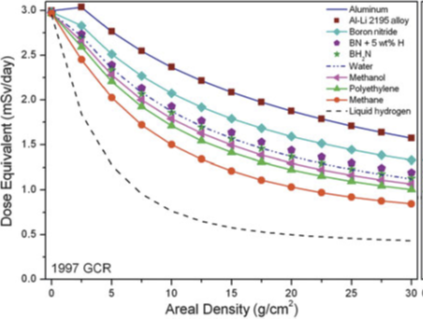Astronaut Underwear - Wearable materials for attenuation of high-energy radiation
Supervisor: Dr. Lyudmila Goncharova
Can extend to MSc?: Yes
Project Description (Abstract):
L.V. Goncharova, in collaboration with J.J. Noël, P. Rogan
Astronauts in space are unavoidably bombarded by ionizing radiation, in the form of both cosmic rays and high-energy particles from the Sun. The high-energy collisions of these primary particles with, for example, the atoms of a spacecraft, space suit, or human body can produce a shower of secondary radiation, in the form of high-energy electrons, X-rays, gamma rays, and neutrons, which contribute significantly to the radiation dose received by astronauts.1 This project will be focused on assessment of light-weight materials that could provide partial radiation shielding and help astronauts limit radiation exposure to below the NASA administrative dose equivalent limit of 500 μSv/yr.2 In this project, in collaboration with Prof. J. Noël (Chemistry) and Prof. P. Rogan (Biochemistry), several material, such as metal foils, boron-based, and carbon-based polymer thin films will be investigated, with a focus on their properties and ability to attenuate protons, alpha particles, as well as neutron fluxes. The neutron cross section is large for some light nuclei, such as hydrogen and boron, both of which can be incorporated abundantly into polymers, making these candidate materials for shielding neutron radiation. Solar ejecta could be simulated using beams of protons and alpha particles in the Tandetron Accelerator. Cosmic rays are too energetic for simulation by the Tandetron; however, their secondary product, neutrons, can be obtained from MNR (Noël). Experimental attenuation properties will be compared with the results of computational analyses using Stopping and Range of Ions in Matter (SRIM) software.3
The student working on this project will access some of Canada’s premier research facilities, including McMaster Nuclear Reactor (MNR) and Western Tandetron accelerator facility. The results of this research will facilitate the development of wearable materials that could shield astronauts from radiation and decrease the extent of cellular damage.
1 S. A. Thibeault, J. H. Kang, G. Sauti, C. Park, C. C. Fay, and G. C. King, MRS Bulletin 40, 836 (2015).
2 M. D. Richard S. Williams; Vol. 2021 (2014).
3 J. F. Ziegler and J. P. Biersack, SRIM-The stopping and range of Ions in Matter Ver.2008 (2008).

Figure 1. Calculated galactic cosmic radiation (GCR) dose equivalent for some state-of-the-art and proposed radiation shielding materials. Adopted from Ref. 1

